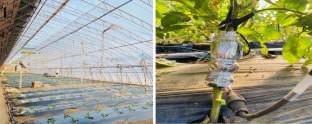Irrigation Science ( IF 3 ) Pub Date : 2023-11-24 , DOI: 10.1007/s00271-023-00895-2 Jiajun Cui , Wenhe Liu , Bo Li , Mingze Yao , Lizhen Mao , Mingyu Zhao , Hongfei Niu , Zhanyang Xu , Feng Zhang , Tieliang Wang , Jingkuan Wang

|
This study aimed to explore how the yield, water use efficiency (WUE), and physiological characteristics of greenhouse-cultivated tomatoes in Northeast China respond to different water and nitrogen treatments during the flowering to fruit set stage (Stage 1), fruiting stage (Stage 2), and ripening stage (Stage 3). Three irrigating upper and lower limits were set at 65% θfc and 75% θfc (W1), 75% θfc and 85% θfc (W2), and 85% θfc and 95% θfc (W3), where θfc represents the field capacity. Three levels of N application were used: N1 (180 kg ha−1), N2 (240 kg ha−1) and N3 (360 kg ha−1). Variance analysis and quadratic curve fitting were employed to characterize the effects of different water and nitrogen treatments on various physiological indicators. The results showed that in Stage 1, the irrigation water use efficiency (WUEi) under N3 was not affected by irrigation water. In Stage 2, there was no significant difference in the photosynthetic rate (Pn) between W3N2 and W2N2. However, the transpiration rate (Tr) in W3N2 was 13.23% higher than that in W2N2, resulting in higher instantaneous water use efficiency (WUEins) under the W2N2 treatment. The diurnal variation in the sap flow rate (SFR) under different water and nitrogen conditions was primarily characterized by a multimodal curve. A quadratic relationship was found between tomato Pn and SFR under different water and nitrogen treatments. In Stage 2, the increase in Pn was accompanied by a greater needed SFR, indicating a decreasing efficiency of photosynthesis in utilizing sap flow. Based on the strength of the correlations between WUEins, intrinsic water use efficiency (WUEin), and WUEi and yield, emphasis should be placed on WUEins during Stage 1 and on WUEi during Stages 2 and 3. The results contribute to improving irrigation and fertilization practices for tomatoes in regions with similar environmental conditions and scientifically promoting transpiration and WUE.
中文翻译:

不同水氮处理对温室番茄产量、水分利用效率及生理反应的影响
本研究旨在探讨东北地区温室栽培番茄在开花至坐果期(Stage 1)、坐果期(Stage 1)的产量、水分利用效率(WUE)和生理特性对不同水氮处理的响应。 2)、成熟阶段(阶段3)。设定 3 个灌溉上限和下限,分别为 65% θ fc和 75% θ fc(W1)、75% θ fc和 85% θ fc(W2)、85% θ fc和 95% θ fc(W3),其中θ fc表示场容量。使用三个施氮水平:N1(180 kg ha -1)、N2(240 kg ha -1)和N3(360 kg ha -1)。采用方差分析和二次曲线拟合表征不同水氮处理对各项生理指标的影响。结果表明,在第一阶段,N3条件下的灌溉水利用效率(WUE i)不受灌溉水的影响。在第2阶段,W3N2和W2N2的光合速率(Pn)没有显着差异。然而,W3N2的蒸腾速率(Tr)比W2N2高13.23%,导致W2N2处理下的瞬时水分利用效率(WUE ins )更高。不同水和氮条件下液流速率(SFR)的日变化主要由多峰曲线表征。在不同的水和氮处理下,番茄 Pn 和 SFR 之间存在二次关系。在第 2 阶段,Pn 的增加伴随着所需 SFR 的增加,表明光合作用利用液流的效率降低。根据 WUE ins、内在水分利用效率 (WUE in ) 以及 WUE i和产量之间的相关性强度,应重点关注第一阶段的WUE ins以及第二和第三阶段的 WUE i。结果有助于改善环境条件相似地区番茄的灌溉和施肥方法,科学促进蒸腾作用和水分利用效率。



























 京公网安备 11010802027423号
京公网安备 11010802027423号